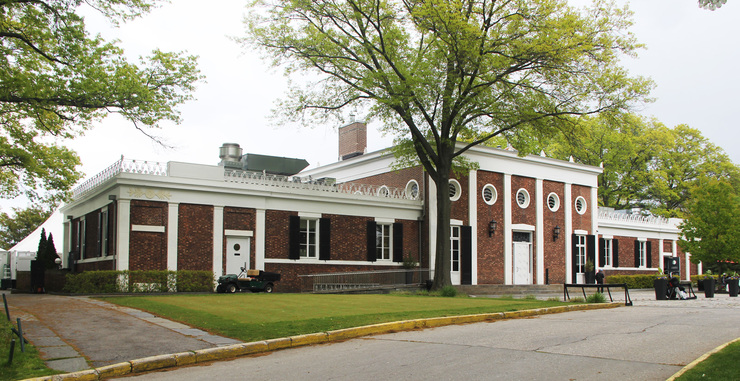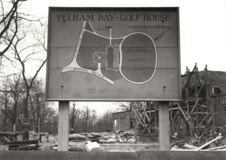
The NYC Department of Parks opened the first municipal golf course in the USA — Van Cortlandt Golf Course in the Bronx — in 1895[1,4]. Unlike all other golf courses at the time, it was open to the public. The concept was so successful it was followed in 1901 by Pell (later Pelham Bay) Golf Course in the Bronx and Forest Park in Queens, also both public. Then, as the Parks Department website notes[1]:
Under the tenure of Parks Commissioner Robert Moses (1934-60), New York City's recreational facilities saw great changes. With federal funding provided by the Works Progress Administration, Moses created a variety of new public facilities and expanded others throughout the city. Between 1935 and 1940, Parks redesigned the entire course and built new club facilities. The Kissena Golf Course opened in 1935. The course in Pelham Bay was renovated in 1936 as part of a WPA-funded project, and the adjacent Split Rock course was opened then. … The stately Pelham Club House (pictured above) also opened during this era[1].

| 
|
| Golf House construction 1936[5] | Finished Golf House mid-late 1930s[5] |
A 1935 New York Times article[4] notes:
When Parks Commissioner Robert Moses took office he quickly decided that the down-at-the-heels system [of poorly maintained public golf courses] with be a “natural” for work relief. On golf-course construction a minimum of materials and equipment is required, with the result that an unusually large proportion of the funds allocated goes directly to labor. John R. Van Kleek, a golf-course architect, was retained to supervise the work, which got under way in February, 1934. Since then approximately $3,5000,000 has been expended — $2,800,000 of it for an average of 3,800 laborers a week. The rest has gone for equipment and materials, including such items as 200 tons of fertilizer and 10,000 tons of manure. Seed purchases (thirty-five tons) completely stripped the market.A Parks Department press release of September 30, 1934[2], notes:
A Golf Club House has been designed by the Architectural Division of the Department of Parks and is a contemporary interpretation of the Greek Revival. The entire exterior is of whitewashed brick with white columns and lintels, The cornices throughout are of wood painted white surmounted with cast iron railings. Green shutters and a base course of bluestone give a striking contrast to the white general scheme, while two bands of bluestone appear on the top of the gray chimneys. The terrace before the portico will be provided with gaily colored tables, chairs and settees. A broad flight of stone steps leads from the terrace to the great lawn. The retaining wall of the terrace is rubble stone with a low parapet wall on which people can lounge while waiting to tee off.
The circular lobby is about twenty-five feet in diameter, wainscotted with Virginia Serpentine Marble, with white stucco walls and contrasting bluestone trim. Here is located the control desk in charge of an attendant, where players may present their credentials, register and receive an assignment. The lobby also gives access to the golf store, the Pro's Shop, and the cafeteria which is served by a modern kitchen.
The locker rooms in connecting wings, with access from the end of the club room, are provided with wash rooms and showers. There is also a ladies' rest room between the locker room and the club room.
Along the entire length of the club room, as it faces the golf course, is a two-story portico fourteen feet wide and carried by six large square columns.
A part of the second story contains office space. The basement is devoted to one of the locker rooms for men and to mechanical equipment, including an oil burner heating plant.
Excavation work for the club house is now under way. All labor and materials for the whole project will be paid for from Work Relief Funds.
The club house was designated an individual New York City landmark in 1968 and added to the National Register of Historic Places in 1982[6].
References:
- The History of Golf Courses in Parks, New York City Department of Parks & Recreation website (accessed 19 May 2017).
- NYC Parks Department Press Release of September 30, 1934. “Seeding has been started by the Department of Parks of the remodeled Pelham Bay Golf Course to permit the building of an additional 18-hole course. The club house will be located at the corner of Shore Road and Split Rock Road to serve both courses.” (The additional course is the Split Rock Golf Course).
- Friends of Pelham Bay Park website, Architecture: “Pelham Bay-Split Rock Golf Course Clubhouse. Built in 1936 under Parks Commissioner Robert Moses. Architect: John Matthews Hatton.” Hatton also worked on other prominent NYC New Deal projects, including Astoria Pool and Play Center in Queens, and Betsy Head Pool and Play Center in Brooklyn.
- Britton, A.D., Taking Mental Hazard out of City Golf, New York Times Magazine, June 2, 1935, p.11.
- Owen, David, The Muny Life: Hidden Art Treasures of New York City Golf, March 2, 2013. Photos from the NYC Parks Department archive.
- Owen, David, “Playing Out of the Snow”, The New Yorker, March 28, 2005, pp.26-32. Tells the story (among others) of how the Club House was restored after it was nearly gutted in a 2001 fire.
- Brechin, Gray, Playing Through: Recreation and the New Deal, Living New Deal News, June 26, 2017.
- NYC Golf Club Houses, Page Ayres Cowley Architecture, LLC: Conditions Assessment, Restoration, Rehabilitation & Adaptive Re-Use — Pelham / Split Rock Golf Clubhouse, accessed 2 November 2019: "PACA, retained as Architect of Record, prepared a conditions assessment and feasibility study for the enlargement and comprehensive upgrade of the clubhouse, designed in 1936 by Aymar Embury II". PACA is the firm that renovated the building in 2009. Also the Parks Department names Embury as the (or a) Split Rock architect on this page.
|
The New Deal in
NYC 1932-1943 |
Frank da Cruz |
fdc@columbia.edu
|